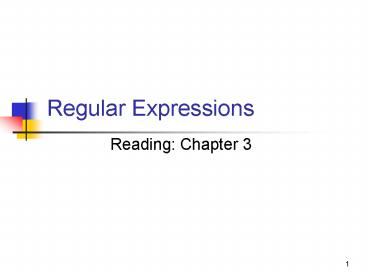Regular Expressions - PowerPoint PPT Presentation
1 / 16
Title:
Regular Expressions
Description:
... Regular Languages = Automata/machines Syntactical expressions ... Expressions Regular Expressions vs. Finite Automata Regular Expressions ... – PowerPoint PPT presentation
Number of Views:294
Avg rating:3.0/5.0
Title: Regular Expressions
1
Regular Expressions
- Reading Chapter 3
2
Regular Expressions vs. Finite Automata
- Offers a declarative way to express the pattern
of any string we want to accept - E.g., 01 10
- Automata gt more machine-like
- lt input string , output accept/reject gt
- Regular expressions gt more program syntax-like
- Unix environments heavily use regular expressions
- E.g., bash shell, grep, vi other editors, sed
- Perl scripting good for string processing
- Lexical analyzers such as Lex or Flex
3
Regular Expressions
Regular expressions
Finite Automata(DFA, NFA, ?-NFA)
Syntactical expressions
Automata/machines
RegularLanguages
Formal language classes
4
Language Operators
- Union of two languages
- L U M all strings that are either in L or M
- Note A union of two languages produces a third
language - Concatenation of two languages
- L . M all strings that are of the form xy
s.t., x ? L and y ? M - The dot operator is usually omitted
- i.e., LM is same as L.M
5
Kleene Closure (the operator)
i here refers to how many strings to
concatenate from the parent language L to produce
strings in the language Li
- Kleene Closure of a given language L
- L0 ?
- L1 w for some w ? L
- L2 w1w2 w1 ? L, w2 ? L (duplicates allowed)
- Li w1w2wi all ws chosen are ? L
(duplicates allowed) - (Note the choice of each wi is independent)
- L Ui0 Li (arbitrary number of concatenations)
- Example
- Let L 1, 00
- L0 ?
- L1 1,00
- L2 11,100,001,0000
- L3 111,1100,1001,10000,000000,00001,00100,0011
- L L0 U L1 U L2 U
6
Kleene Closure (special notes)
- L is an infinite set iff L1 and L??
- If L?, then L ?
- If L F, then L ?
- S denotes the set of all words over an alphabet
S - Therefore, an abbreviated way of saying there is
an arbitrary language L over an alphabet S is - L ? S
Why?
Why?
Why?
7
Building Regular Expressions
- Let E be a regular expression and the language
represented by E is L(E) - Then
- (E) E
- L(E F) L(E) U L(F)
- L(E F) L(E) L(F)
- L(E) (L(E))
8
Example how to use these regular expression
properties and language operators?
- L w w is a binary string which does not
contain two consecutive 0s or two consecutive 1s
anywhere) - E.g., w 01010101 is in L, while w 10010 is
not in L - Goal Build a regular expression for L
- Four cases for w
- Case A w starts with 0 and w is even
- Case B w starts with 1 and w is even
- Case C w starts with 0 and w is odd
- Case D w starts with 1 and w is odd
- Regular expression for the four cases
- Case A (01)
- Case B (10)
- Case C 0(10)
- Case D 1(01)
- Since L is the union of all 4 cases
- Reg Exp for L (01) (10) 0(10) 1(01)
- If we introduce ? then the regular expression can
be simplified to - Reg Exp for L (? 1)(01)(? 0)
9
Precedence of Operators
- Highest to lowest
- operator (star)
- . (concatenation)
- operator
- Example
- 01 1 ( 0 . ((1)) ) 1
10
Finite Automata (FA) Regular Expressions (Reg
Ex)
- To show that they are interchangeable, consider
the following theorems - Theorem 1 For every DFA A there exists a regular
expression R such that L(R)L(A) - Theorem 2 For every regular expression R there
exists an ? -NFA E such that L(E)L(R)
Proofs in the book
? -NFA
NFA
Kleene Theorem
Theorem 2
DFA
Reg Ex
Theorem 1
11
DFA to RE construction
Reg Ex
DFA
Theorem 1
Informally, trace all distinct paths (traversing
cycles only once) from the start state to each
of the final states and enumerate all the
expressions along the way
Example
0,1
1
0
0
1
q0
q1
q2
Q) What is the language?
12
RE to ?-NFA construction
? -NFA
Reg Ex
Theorem 2
(01)01(01)
Example
(01)
01
(01)
13
Algebraic Laws of Regular Expressions
- Commutative
- EF FE
- Associative
- (EF)G E(FG)
- (EF)G E(FG)
- Identity
- EF E
- ? E E ? E
- Annihilator
- FE EF F
14
Algebraic Laws
- Distributive
- E(FG) EF EG
- (FG)E FEGE
- Idempotent E E E
- Involving Kleene closures
- (E) E
- F ?
- ? ?
- E EE
- E? ? E
15
True or False?
- Let R and S be two regular expressions. Then
- ((R)) R ?
- (RS) R S ?
- (RS R) RS (RRS) ?
16
Summary
- Regular expressions
- Equivalence to finite automata
- DFA to regular expression conversion
- Regular expression to ?-NFA conversion
- Algebraic laws of regular expressions
- Unix regular expressions and Lexical Analyzer































